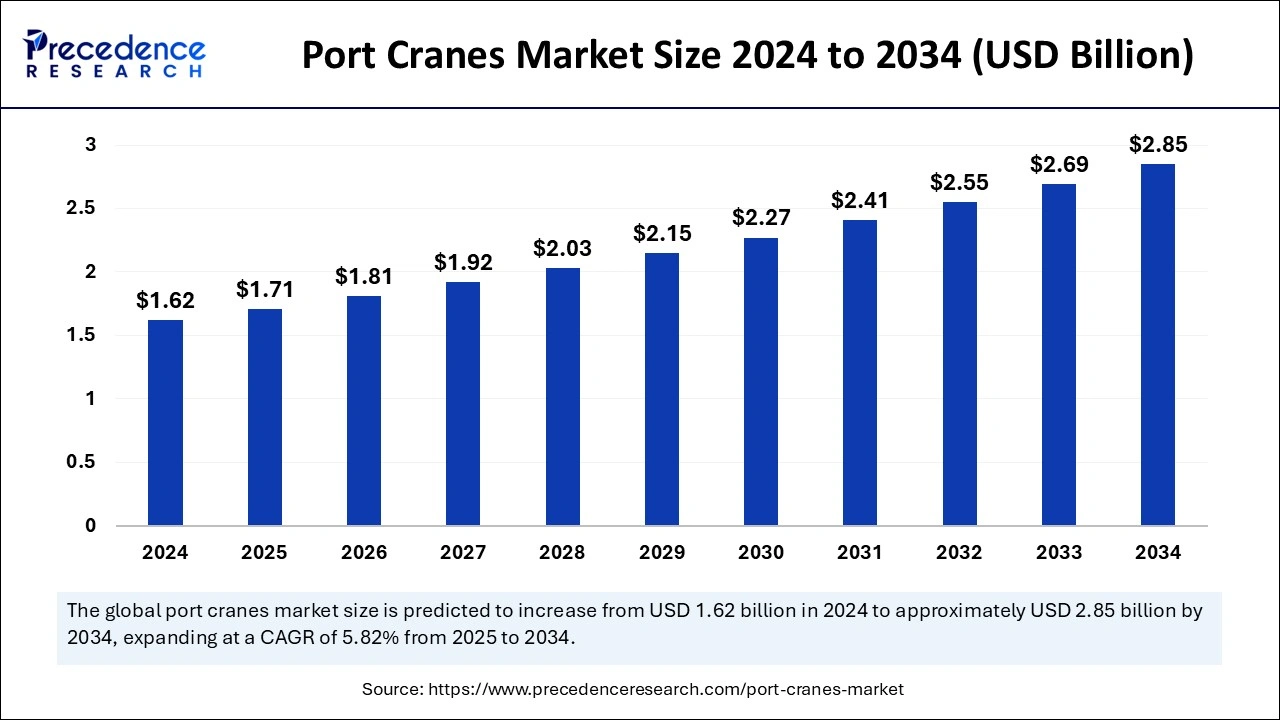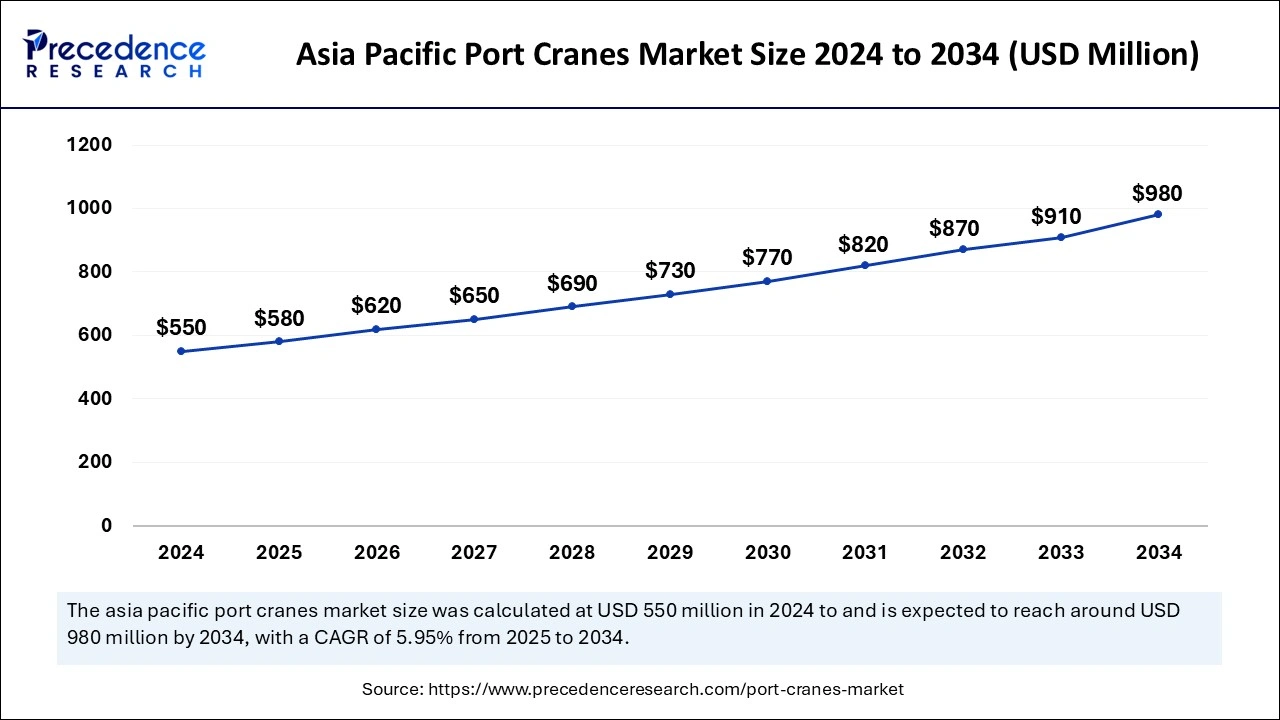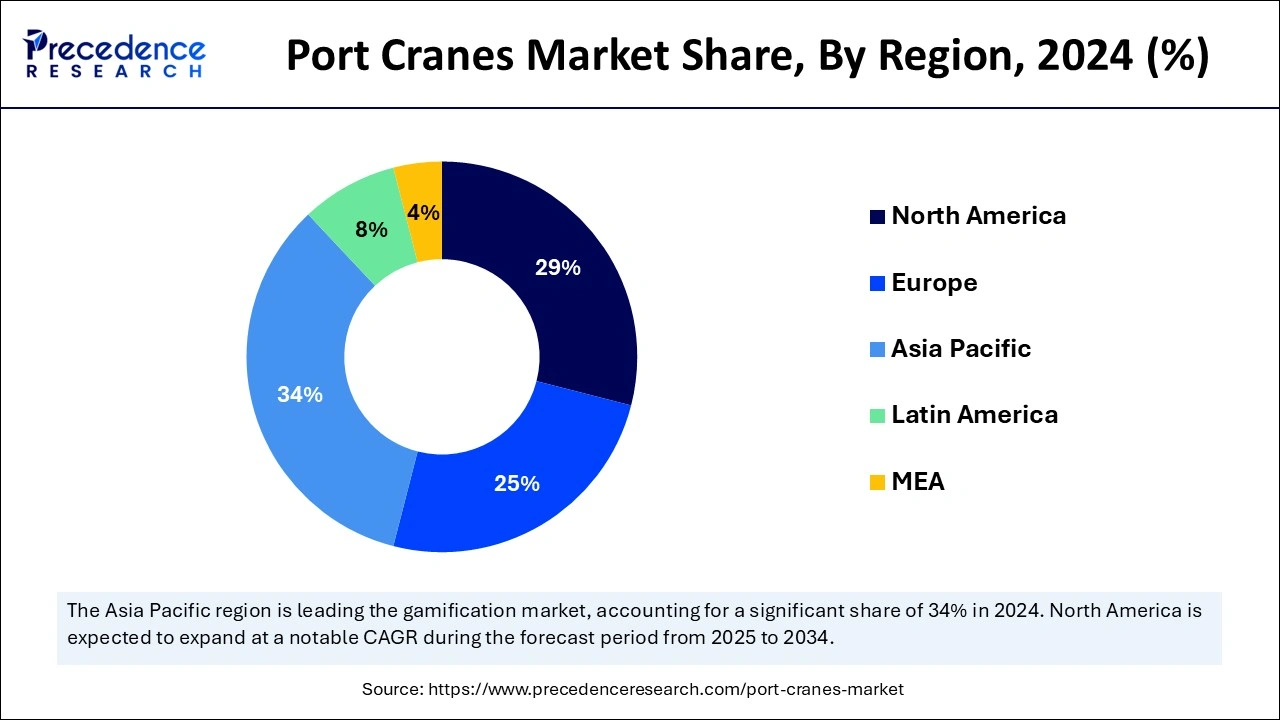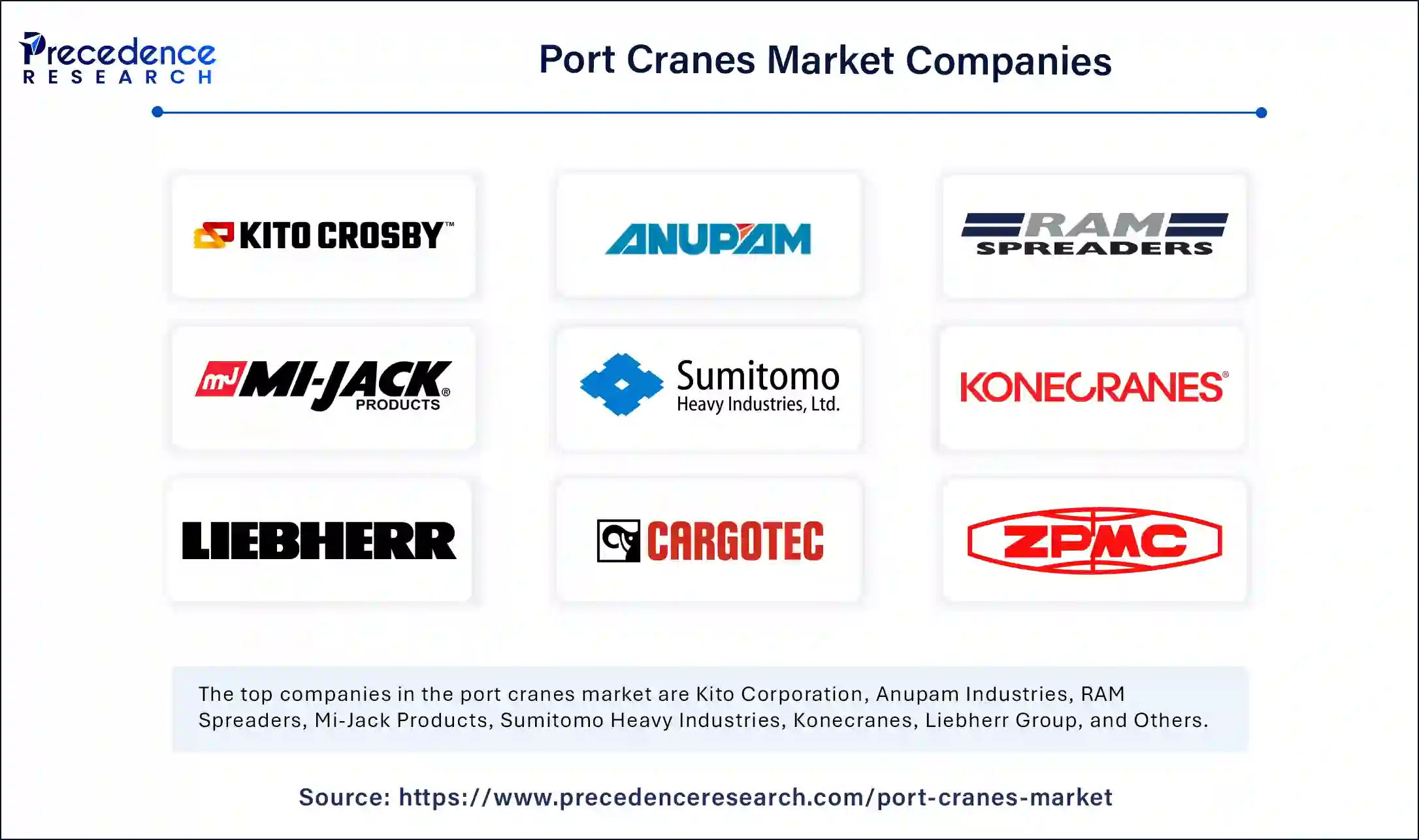The global port cranes market size is calculated at USD 1.71 billion in 2025 and is forecasted to reach around USD 2.85 billion by 2034, accelerating at a CAGR of 5.82% from 2025 to 2034. The Asia Pacific market size surpassed USD 550 million in 2024 and is expanding at a CAGR of 5.95% during the forecast period. The market sizing and forecasts are revenue-based (USD Million/Billion), with 2024 as the base year.
The global port cranes market size was estimated at USD 1.62 billion in 2024 and is predicted to increase from USD 1.71 billion in 2025 to approximately USD 2.85 billion by 2034, expanding at a CAGR of 5.82% from 2025 to 2034. The increasing demand for technologically advanced and automated cargo shipment machinery to and from ships is driving the growth of the market.

The port cranes market is one of the important parts of any type of shipment facility. The port cranes usually help load and offload cargo to and from ships and within port terminals. These are the heavy-duty machinery built on the gantry frame. There are some types of port cranes used in the shipment or port facilities, such as rubber-tired gantry cranes, rail-mounted gantry cranes, automatic stacking cranes, ship-to-shore cranes, deck cranes, crane barges, tower cranes, reach stackers, and level luffing cranes which are used in the different port facilities.
The integration of artificial intelligence into the advancements of the port cranes market has led to improved operational efficiency. AI is the major technological advancement in smart ports and port automation; it helps in providing enhancements in security improvements, vessel turnaround time, vessel route, and container dwell time optimization. AI also enables real-time performance. AI can handle the increase in traffic and cargo, minimize human error, optimize employee working hours, and more productive supply chain management.
The Asia Pacific port cranes market size was exhibited at USD 550 million in 2024 and is projected to be worth around USD 980 million by 2034, growing at a CAGR of 5.95% from 2025 to 2034.

Asia Pacific dominated the global port cranes market in 2024. The growth of the market is attributed to the rising economic development in regional countries like China, India, Japan, and South Korea, which drives the infrastructural development and trade activities in the countries are driving the growth of the shipping industry, which led to the increasing development of technologically advanced and machinery in the ports are contributing to the expansion of the market. Additionally, the rising government investments in the development of trade activities and international imports and exports are accelerating the growth of the port crane market in the region.

North America is expecting substantial growth in the port cranes market during the predicted period. The rise in the market is owing to the presence of well-established infrastructure and the international import and export activities driving the demand for advanced ports with the availability of technologically advanced machinery and cranes driving the demand for the port cranes. The increasing availability of the leading manufacturing unit for advanced machinery and heavy-duty vehicles across the region.
| Report Coverage | Details |
| Market Size by 2024 | USD 1.62 Billion |
| Market Size in 2025 | USD 1.71 Billion |
| Market Size in 2034 | USD 2.85 Billion |
| Market Growth Rate from 2025 to 2034 | CAGR of 5.82% |
| Dominating Region | Asia Pacific |
| Fastest Growing Region | North America |
| Base Year | 2024 |
| Forecast Period | 2025 to 2034 |
| Segments Covered | Type, Crane Capacity, Power Source, Control Method, Application, and Regions. |
| Regions Covered | North America, Europe, Asia-Pacific, Latin America, and Middle East & Africa. |
Rise in import and export activities
The increasing adoption of trade activities for economic development across several countries for economic stability, enhanced revenue, reduced competition, longer product lifespan, risk management, easier cash-flow management, advantages in currency exchange, export financing, enhanced reputation, and others. The increasing government intervention in international trade activities is causing the demand for efficient operational locations or product shipping ports, leading to the increased demand for heavy-duty machinery for loading and offloading operations that boosts the growth of the market.
High cost
The increased cost of port cranes due to their high cost of machinery, components, energy consumption rate, and maintenance cost is collectively limiting the growth of the port cranes market.
Technological advancements in port cranes
Technological advancements in the port cranes and advanced machinery with the integration of the Internet of Things(IoT), automation, digitization, and remote operations drive the growth of the port cranes market. Advancements such as automation in the port cranes for enhancing performance, efficiency, safer and more precise shipping of cargo, optimizing resource utilization, and reducing operational time and cost boost profitability with less cost consumption that collectively drives the growth of the port cranes market.
The gantry cranes segment led the global port cranes market in 2024. The gantry cranes are heavy-weight and heavy-loading capacity cranes that are majorly used by the port authorities for the shipment of containers or logistics into the ship or at the time of offloading. It is an overhead type of crane that has a single or double girder configuration supported by freestanding legs that move on tracks or on the rail system. Different types of gantry cranes are used according to the size and operations of the port. Furthermore, the types include full gantry crane systems, semi-gantry crane systems, portable gantry crane systems, and adjustable gantry cranes.
The overhead cranes segment will experience notable growth in the forecast period. There is an increasing demand for overhead cranes for heavy-weight operations in different industrial areas. It is heavy-duty machinery made for the efficient movement of highly heavy-load equipment and vehicles within the manufacturing unit. The overhead cranes are equipped with different parts and specifications, including a bridge, lifting trolly, driving mechanism, power supply, height, remote control, and hoist.
The medium capacity segment accounted for a significant share of the port cranes market in 2024. The increasing demand for the highly precise, cost-effective, flexible, and versatile type of port cranes that will used in a number of port or marine applications boosts the demand for medium-capacity port cranes. They provide benefits like higher operational flexibility, efficient handling of heavy-weight containers, general cargo, and safe other port applications.
The small capacity segment expects substantial growth during the predicted period. The small capacity port cranes are widely used in the different small-scale loading and offloading applications within the limited space. It is a small and cost-effective solution for different port or marine applications.
The diesel power source segment led the global port cranes market in 2024. The increasing adoption of disease-powered port cranes due to their higher effectiveness and capability of loading and offloading large vessels and containers from one place to another. These are the more reliable type of port cranes, which are widely accepted by a number of leading ports across the world.
The hybrid power source segment expects substantial growth in the market during the predicted period. The increasing advancements in automobile technology and the acceptance of the electric or hybrid culture in the automobile reduce carbon emissions and flexibility in operations. The increasing awareness regarding environmental pollution due to the carbon emission by disease cranes is driving the demand for the hybrid power source port cranes segment.
The manual segment dominated the port cranes market in 2024. The increasing adoption of manual port cranes due to the overall control over the crane, increased reliability, cost-effectiveness, and flexibility in operations. Manual cranes can lift higher-weight material or components precisely and safely, which reduces the risk of damaging the containers or products.
The automated segment expects substantial growth during the predicted period. The rising advancements in the technologies of automobiles and heavy-weight machinery, along with the integration of automation, IoT, sensors, and other technologies, provide more accuracy in operations and other shipping applications in ports. The automated port cranes enhanced productivity, safety, efficiency, and others.
The shipbuilding industry segment dominated the global port cranes market in 2024. Port cranes are one of the important parts of the shipbuilding industry; they play a wide role in shipbuilding, whether placing large vessels or loading and offloading containers from ships. The port cranes help in construction from large containers or large capacity vessels to small boats. The shipbuilding industry uses a large amount of heavyweight equipment and materials in the manufacturing of ships. Cranes are used to help with placing heavy machinery and equipment into their designated place with more precision and safety.
The construction industry segment will witness significant growth during the predicted period. The rising demand for large vessels is driving the demand for ship construction port cranes. Cranes play a crucial role in the construction industry in the different applications of indoor lifting, loading, and offloading heavy-weight materials for efficient working on rough terrains like rocky, dirt, and uneven terrain.

By Type
By Application
By Crane Capacity
By Power Source
By Control Method
By Geography
For inquiries regarding discounts, bulk purchases, or customization requests, please contact us at sales@precedenceresearch.com
No cookie-cutter, only authentic analysis – take the 1st step to become a Precedence Research client